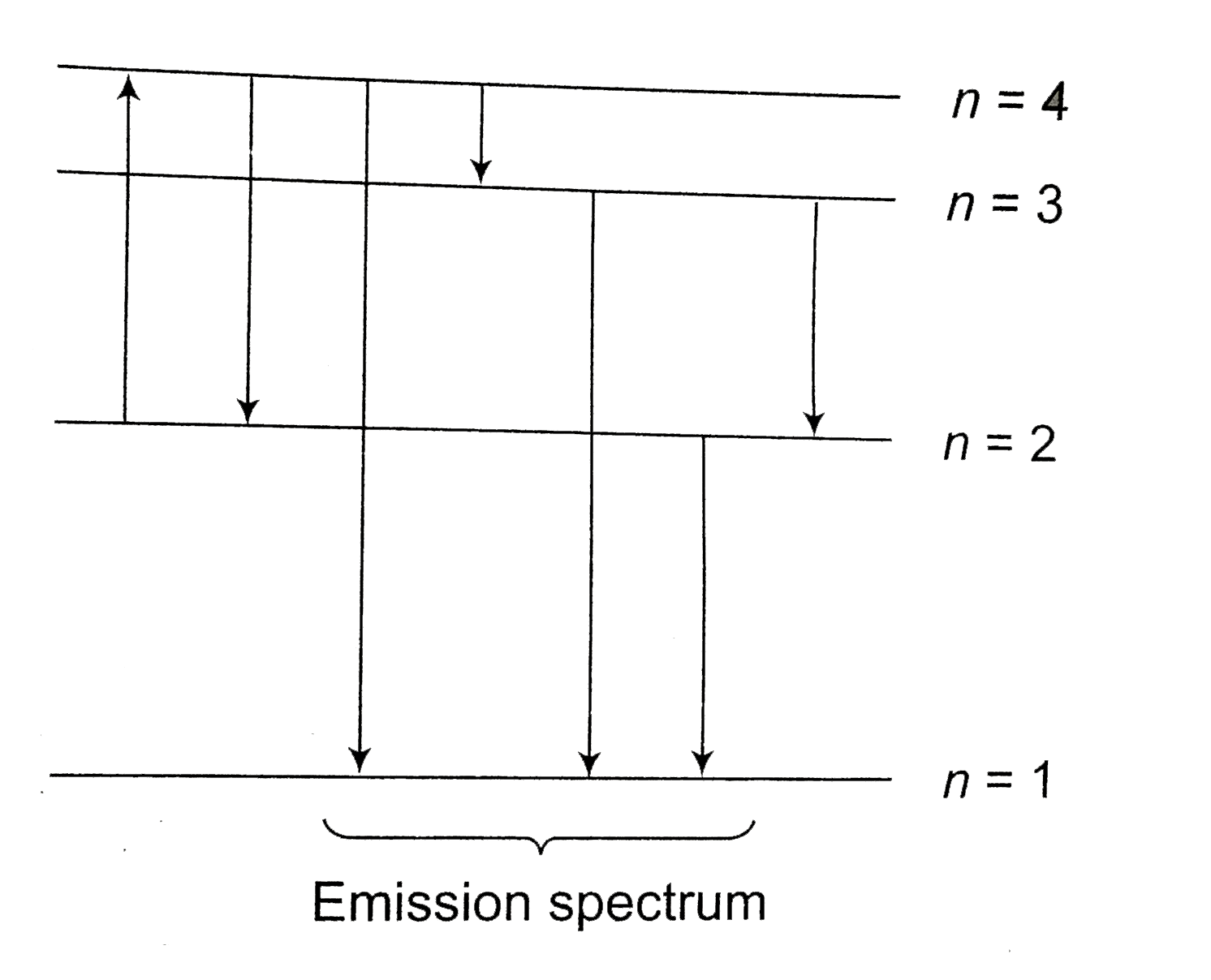A gas of identical hydrogen-like atoms has some atoms in the lowest in lower (ground) energy level and some atoms in a partical upper (excited) energy level and there are no atoms in any other energy level.The atoms of the gas make transition to higher energy level by absorbing monochromatic light of photon energy .
Subsequenty , the atom emit radiation of only six different photon energies. Some of the emitted photons have energy some have energy more , and some have less than .
a Find the principal quantum number of the intially excited level
b Find the ionization energy for the gas atoms.
c Find the maximum and the minimum energies of the emitted photons.
(a) Six lines are emission spectrum
n=4
That is atom goes to excited state corresponding to n=4. Since some emitted photons have energy lt 2.7 eV i.e. there should be an energy level between initial level and n=4. Hence quantum number corresponding to initial excited level =2.

Ionisation energy =14.3 eV
(c)
Topper's Solved these Questions
Similar Questions
A gas of identical H-like atom has some atoms in the lowest (ground) energy level A and some atoms in a particular upper (excited) energy level B and there are no atoms in any other energy level. The atoms of the gas make transition to a higher energy level by aborbing monochromatic light of photon energy 2.7eV. Subsequently, the atoms emit radiation of only six different photons energies. Some of the emitted photons have energy 2.7eV. Some have more and some have less than 2.7eV.
(a) Find the principal quantum number of initially excitied level B.
(b) Find the ionisation energy for the gas atoms.
(c ) Find the maximum and the minimum energies of the emitted photons.
View SolutionA gas of identical hydrogen like atomos has some atoms in ground state and some atoms in a particular exceited state and dthere are no atoms in any other energy level. The atoms of the gas make transition to a higher energy stte by absrobing monochromatic light of wavelenght 304 ∘A. Subsequencly, the atoms emit radiation of only six different photon energies. Some of emitted photons have wavelenght 304∘A, some wavelength more and some have less that 304overeset(∘)A (Take he=12420eV−∘A)
Find the principal quantum number of the initially excicted state.
View Solution
Knowledge Check
Find the excitation energy of n = 3 level of He atom
A48.4 eVB2.4 eVC3.8 eVD24.2 eVIn a sample of hydrogen atoms, all the atoms exist in two energy levels A and B. A is the ground level and B is some higher energy level. These atoms absorb photons of energy 2.7 eV and attain a higher energy level C.After this, these atoms emit photons of six different energies. Some of these photon energies are higher than 2.7 eV, some equal to 2.7 eV and some are loss than 2.7 eV.
The principal quantum number corresponding to energy level B isA1B2C3D4In a sample of hydrogen atoms, all the atoms exist in two energy levels A and B. A is the ground level and B is some higher energy level. These atoms absorb photons of energy 2.7 eV and attain a higher energy level C.After this, these atoms emit photons of six different energies. Some of these photon energies are higher than 2.7 eV, some equal to 2.7 eV and some are loss than 2.7 eV.
The principal quantum number corresponding to energy level C isA1B2C3D4
A gas of identical hydrogen like atomos has some atoms in ground state and some atoms in a particular exceited state and dthere are no atoms in any other energy level. The atoms of the gas make transition to a higher energy stte by absrobing monochromatic light of wavelenght 304 ∘A. Subsequencly, the atoms emit radiation of only six different photon energies. Some of emitted photons have wavelenght 304∘A, some wavelength more and some have less that 304overeset(∘)A (Take he=12420eV−∘A)
Identify the gas (Z=?)
View SolutionA gas of identical hydrogen-like atoms has some atoms in the lowest in lower (ground) energy level A and some atoms in a partical upper (excited) energy level B and there are no atoms in any other energy level.The atoms of the gas make transition to higher energy level by absorbing monochromatic light of photon energy 2.7eV.
Subsequenty , the atom emit radiation of only six different photon energies. Some of the emitted photons have energy 2.7eV some have energy more , and some have less than 2.7eV.
a Find the principal quantum number of the intially excited level B
b Find the ionization energy for the gas atoms.
c Find the maximum and the minimum energies of the emitted photons.
View SolutionA gas of identical hydrogen like atomos has some atoms in ground state and some atoms in a particular exceited state and dthere are no atoms in any other energy level. The atoms of the gas make transition to a higher energy stte by absrobing monochromatic light of wavelenght 304 ∘A. Subsequencly, the atoms emit radiation of only six different photon energies. Some of emitted photons have wavelenght 304∘A, some wavelength more and some have less that 304overeset(∘)A (Take he=12420eV−∘A)
Find the maximum and minimum energies of emitted photosn (in eV)
View SolutionEnergy Level Of Hydrogen Atoms
View SolutionIn a sample of hydrogen atoms, all the atoms exist in two energy levels A and B. A is the ground level and B is some higher energy level. These atoms absorb photons of energy 2.7 eV and attain a higher energy level C.After this, these atoms emit photons of six different energies. Some of these photon energies are higher than 2.7 eV, some equal to 2.7 eV and some are loss than 2.7 eV.
The atomic number of these atoms is
View Solution
